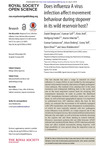Does influenza A virus infection affect movement behaviour during stopover in its wild reservoir host?

View/
Date
2016Author
Bengtsson, Daniel
Safi, Kamran
Avril, Alexis
Metadata
Show full item recordAbstract
The last decade has seen a surge in research on avian influenza A viruses (IAVs), in part fuelled by the emergence, spread and potential zoonotic importance of highly pathogenic virus subtypes. The mallard (Anas platyrhynchos) is the most numerous and widespread dabbling duck in the world, and one of the most important natural hosts for studying IAV transmission dynamics. In order to predict the likelihood of IAV transmission between individual ducks and to other hosts, as well as between geographical regions, it is important to understand how IAV infection affects the host.
Collections
- Education [806]
